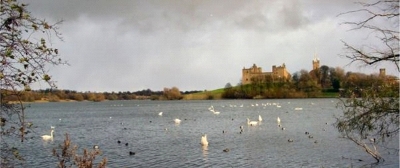47. Linlithgow Loch
Linlithgow Loch is a large "kettle hole" formed by the melting of a large detached mass of ice trapped within glacial deposits, which insulated it and delayed its melting.

When the block of trapped ice did melt it left behind a hollow that filled with water; this loch is in the kettle hole. It is the largest freshwater loch in West Lothian and is adjacent to Linlithgow Palace. The Palace is a visitor attraction in the care of Historic Environment Scotland (HES). It is largely built from thinly bedded sandstone which weathers to a distinctive variable orange and cream colour. This came from Kingscavil Quarry, a few kilometres east of the town. The quarry is now infilled. Linlithgow Lock is designated a Site of Special Scientific Interest (SSSI) as an example of a lowland eutrophic loch.
The entire perimeter of the loch is accessible and there are various car parks off Linlithgow High Street. Nearby geodiversity sites are Union Canal Museum (22), Carsie Hill (35) and Kildimmery Fishery Quarry (43).



